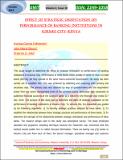| dc.description.abstract | This study sought to determine the effect of strategic orientation on performance of banking institutions in Kisumu City. Performance of these banks varies greatly in terms of return on total assets (ROTA) yet they operate in the same macro-economic environment. No study has been carried out to establish this. This was achieved by obtaining and analyzing both primary and secondary data. The primary data was obtained by way of questionnaires and the respondents drawn from the senior management level of the surveyed banks. Secondary data comprised of published financial accounts of the surveyed banks as a whole for the financial year ended 31st Dec. 2010. The purpose of this study was to determine the effect of strategic orientation on the performance of banking institutions in Kisumu City. To achieve this, the researcher was guided by the following objectives: 1) To identify strategic practices adopted by these banks. 2) To establish the relationship between these strategic practices and performance of these banks. 3) To determine the strength of the relationship between strategic orientation and performance of these banks. The research design used in this study was descriptive survey. The study employed saturated and purposive sampling technique because the researcher was convinced that this method would enable him to collect focused information. There are twenty one (21) banks in Kisumu City and from each of them, the branch manager, operations manager and customer service officers were requested to complete a set of questionnaires. Face to face interviews was also conducted to ensure all areas of interest were captured. This made a sample size of sixty three (63). Data analysis was carried out using both descriptive and inferential statistics. The descriptive statistical tools used were totals, mean, standard deviation, and percentages. The inferential statistical tools used were product-moment correlation, coefficient of determination (r2), student t-test and regression analysis. The results of the findings were then presented in the form of Tables, charts and figures. The survey revealed that firms adopting prospector strategy perform better than firms with other forms of strategies. The study also showed that there is good correlation between strategic orientation and performance. This conforms to earlier studies by other scholars. The study also revealed that privately owned banks tend to adopt defender strategy. The study concludes by recommending that further studies need to be carried out to establish why most privately owned banks in Kisumu City tend to adopt defender strategy. | en_US |

